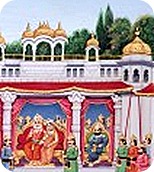 “That country is looking so beautiful, and the Vedas have described its purity. Known in the three worlds, Tirahut [Janakpur] is the tilaka of the earth.” (Janaki Mangala, Svayamvara Ki Taiyari, 4)
“That country is looking so beautiful, and the Vedas have described its purity. Known in the three worlds, Tirahut [Janakpur] is the tilaka of the earth.” (Janaki Mangala, Svayamvara Ki Taiyari, 4)
desa suhāvana pāvana beda bakhāniya |
bhūmi tilaka sama tirahuti tribhuvana jāniya ||
bhūmi tilaka sama tirahuti tribhuvana jāniya ||
For the Vaishnava, the tilaka is the sacred marking on the body representing the link to Lord Vishnu, the Supreme Personality of Godhead. More than just an enigmatic figure to be contemplated on within the mind, the person who is the reservoir of all energies has features that are identifiable through accessing authorized information passed on in a chain of disciplic succession. The highest form of worship is to concentrate on those attributes and become attracted to them. The devotee of Vishnu wears a tilaka on several parts of the body, and most prominently on the forehead, to indicate the various marks of Vishnu, to show that there is a dedication to worshiping Him, in any of His non-different forms. For Goswami Tulsidas, the sacred mark on the earth, the place where Vishnu’s impression is very nicely felt, is Tirahut, or the ancient kingdom of Janakpur where Vishnu’s incarnation of Rama married the beloved daughter of King Janaka, Sita Devi.
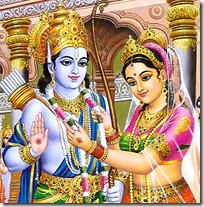 Why this land over others? Why not declare Ayodhya to be the tilaka, or even Vrindavana, where Vishnu appeared as Krishna? In the Janaki Mangala, the poet is mentally travelling back in time to when Lord Rama was about to win the hand of Sita Devi. The marriage of the Supreme Lord to His eternal consort is as anticipated for devotees as the marriage of a close friend or relative is for the average person. A wedding is a time to come together, an excuse for people who haven’t seen one another in a long time to meet up. The event itself focuses on the shared love and commitment of two people.
Why this land over others? Why not declare Ayodhya to be the tilaka, or even Vrindavana, where Vishnu appeared as Krishna? In the Janaki Mangala, the poet is mentally travelling back in time to when Lord Rama was about to win the hand of Sita Devi. The marriage of the Supreme Lord to His eternal consort is as anticipated for devotees as the marriage of a close friend or relative is for the average person. A wedding is a time to come together, an excuse for people who haven’t seen one another in a long time to meet up. The event itself focuses on the shared love and commitment of two people.
Since the wedding already has purity built into it, the higher the character of the participants, the more important the event will be. With Sita’s marriage, there was an air of uncertainty, as it was to be a self-choice ceremony, or svayamvara. No one knew going in who the groom was going to be. The reason for this was that the king giving away Sita’s hand in marriage had no idea who Sita’s parents were. He had found her as a child one day while ploughing a field. Based on her characteristics, the king knew that he couldn’t just give her away to any man when the time for marriage arrived. After feeling helpless, like a man stuck in an ocean without a raft to get him across, he decided to hold a contest, where the person who could lift Lord Shiva’s illustrious bow would win his precious adopted daughter’s company for life.
“Knowing me to be one not born of any mother's womb, the king, after great thought, was unable to find a suitable husband for me.” (Sita Devi speaking to Anasuya, Valmiki Ramayana, Ayodhya Kand, 118.37)
Based on Sita’s spotless character, there could only be one match for her. Though at the time of writing, the poet was well aware of who would win the contest, for the pleasure of his mind he still travelled back to that fateful day and relived the events. The land that hosted the contest is known as a tilaka, or most important mark on the earth, because of Sita and Rama’s presence there. Another benefit of the tilaka is that it immediately reminds others of Vishnu. Just as we can recognize a police officer by their uniform and a priest by the type of shirt they have on, a Vaishnava, a devotee of Vishnu, can be easily spotted by the tilaka mark on the head or the tulasi beads around the neck. Even if these things should be absent, the person who always chants the glories of Vishnu stands out as a Vaishnava.
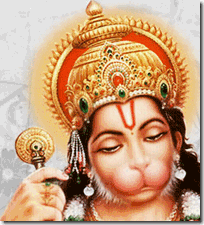 What is the significance in noting the tilaka? For the person immersed in Rama-lila, just hearing the word Tirahut or Janakpur immediately brings to mind the time Rama lifted up Lord Shiva’s bow and married Sita. What better image could there be for the mind to contemplate on? The sacred places on this earth are marked with the footprints of Vishnu during His several descents in avatara forms. The places of pilgrimage are those where noteworthy events relating to the Lord took place. Janakpur was certainly one of those places.
What is the significance in noting the tilaka? For the person immersed in Rama-lila, just hearing the word Tirahut or Janakpur immediately brings to mind the time Rama lifted up Lord Shiva’s bow and married Sita. What better image could there be for the mind to contemplate on? The sacred places on this earth are marked with the footprints of Vishnu during His several descents in avatara forms. The places of pilgrimage are those where noteworthy events relating to the Lord took place. Janakpur was certainly one of those places.
Tirahut also brings to mind King Janaka and his pious character. He was very famous throughout the world during his time, for his dedication to piety was unmatched. He was also an expert mystic, which meant that he was above the influence of the senses. For a king that is a very rare accomplishment, for the appeal of being king is that you get to enjoy heavenly delights and opulence while still on earth. The President of the United States flies around on Air Force One and can eat whatever he desires at any time of the day. He even gets to vacation in wonderful places. Kings similarly are supplied with whatever they desire at a moment’s notice. How then could a king like Janaka be above the influence of the senses, especially when his desires could be met so easily?
Let’s think of it this way. Imagine being known for your control over eating. You meticulously measure the portion sizes of the food you are going to eat, and you never indulge in anything that will be bad for you. Thus you maintain a slim physique and never suffer from illness. Keeping the internal airs of the body in balance, you never put stress on yourself from eating. Surely you are not that rare, as many people aren’t overweight. But what about if we said that you did this while sitting in front of a buffet cart for eight hours a day? Let’s say that you worked in a place where you could eat whatever you wanted at any time of the day, at no charge. These circumstances make your controlled eating all the more impressive.
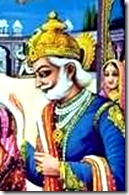 Take the example of getting to eat whatever you want and extend it out to every sensual pursuit, and you have what the average king’s lifestyle is like. Yet Janaka was so dedicated to piety, so knowledgeable of dharma and how to maintain one’s essential characteristic, that he was known as Videha, or bodiless. The senses had no influence on him. What’s more is that he even advanced past the stage of mystic yoga and became a full-fledged devotee, someone so devoted that he is today known as one of the twelve mahajanas, or authorities on devotional service.
Take the example of getting to eat whatever you want and extend it out to every sensual pursuit, and you have what the average king’s lifestyle is like. Yet Janaka was so dedicated to piety, so knowledgeable of dharma and how to maintain one’s essential characteristic, that he was known as Videha, or bodiless. The senses had no influence on him. What’s more is that he even advanced past the stage of mystic yoga and became a full-fledged devotee, someone so devoted that he is today known as one of the twelve mahajanas, or authorities on devotional service.“Lord Brahma, Bhagavan Narada, Lord Shiva, the four Kumaras, Lord Kapila [the son of Devahuti], Svayambhuva Manu, Prahlada Maharaja, Janaka Maharaja, Grandfather Bhishma, Bali Maharaja, Shukadeva Gosvami and I myself know the real religious principle.” (Yamaraja, Shrimad Bhagavatam, 6.3.20)
A mahajana is a great soul because of their qualities exhibited in dealings with others and also their ability to teach others about the right path in life. The twelve mahajanas relating to devotional service are listed in the Shrimad Bhagavatam, or Bhagavata Purana. It should be noted that not all the personalities mentioned are direct worshipers of Lord Vishnu. For instance, Prahlada Maharaja was a devotee of Vishnu, but he got to offer prayers to the Lord in His half-man/half-lion form of Narasimhadeva. Lord Shiva especially prefers to worship Vishnu as Lord Rama. Regardless of who was specifically worshiped, their interactions with Vishnu and their staunch devotion to him made them eligible to be known as authority figures, people that others can look to for guidance.
What did Janaka specifically do to be listed as one of the authorities on devotional service? For starters, his Videha position did not preclude him from picking up the baby in the ground and harboring affection for her. Janaka, though above the influence of the senses, immediately harbored parental affection for this precious little girl found in the field. As if the keepers of heaven knew what was in his mind, a voice in the sky then came upon the scene and said that this girl was Janaka’s daughter in all righteousness, or dharma. Janaka needed to hear this because he never did anything outside the bounds of piety. The voice basically gave him the okay to love this girl as his daughter and take care of her.
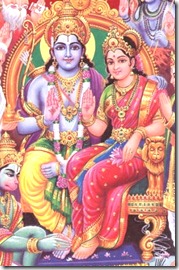 From the events described in the Janaki Mangala, we learn that Janaka would also get a tremendous thrill upon meeting Shri Rama and His younger brother Lakshmana. Vishnu is not alone in the spiritual world. God has a family like we do. His eternal consort is Lakshmi Devi, who is Sita. His protector, His number one servitor, is Ananta Shesha Naga, who is Lakshmana. Janaka did not break his high position of being desire-less when meeting Sita, Rama and Lakshmana for the first time. Rather, his mastery over mystic yoga and his pious nature made him eligible for experiencing the transcendental bliss that comes with God’s association.
From the events described in the Janaki Mangala, we learn that Janaka would also get a tremendous thrill upon meeting Shri Rama and His younger brother Lakshmana. Vishnu is not alone in the spiritual world. God has a family like we do. His eternal consort is Lakshmi Devi, who is Sita. His protector, His number one servitor, is Ananta Shesha Naga, who is Lakshmana. Janaka did not break his high position of being desire-less when meeting Sita, Rama and Lakshmana for the first time. Rather, his mastery over mystic yoga and his pious nature made him eligible for experiencing the transcendental bliss that comes with God’s association.
That same thrill can be felt by those who hear of Sita and Rama’s glorious activities. The stage for one of their most memorable interactions was the land of Tirahut, which thus made it worthy of being called a tilaka. Just as Janaka’s kingdom is sacred for its rich history and the pious people who lived there, the incomparably brilliant works of the saint Tulsidas are forever sacred. He wrote the Janaki Mangala to stay connected in the mind with Sita and Rama, and we read his works so that we can gain his association. No other benefit in life can compare with the company of the saints, who are like travelling tirthas, bringing auspiciousness and good cheer wherever they go. The pages that house the words born in their minds thus also become sacred, like tilaka, for they immediately remind one of Vishnu and devotion to Him.
In Closing:
Tilaka is the sacred mark to treasure,
Reminds one of Vishnu, reservoir of pleasure.
The tilaka on the head Vaishnavas do show,
So that their link to Vishnu others can know.
Tulsidas says that earth of Tirahut is the tilaka,
Place where Sita lived with father Janaka.
Hosted the greatest marriage of all time,
Brought princes from around the world, every kind.
Land earned tilaka status with Rama’s arrival,
His lifting of Shiva’s bow, secured Sita’s nuptial.
Works of the saints are like travelling pilgrimage place,
Its pages bring God’s company, put smile on the face.
Janaka forever celebrated for his pious nature,
His ceremony for Sita’s wedding mind’s treasure.
No comments:
Post a Comment